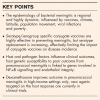Acute bacterial meningitis
- PMID: 33767093
- PMCID: PMC7610733
- DOI: 10.1097/WCO.0000000000000934
Acute bacterial meningitis
Abstract
Purpose of review: Community-acquired bacterial meningitis is a continually changing disease. This review summarises both dynamic epidemiology and emerging data on pathogenesis. Updated clinical guidelines are discussed, new agents undergoing clinical trials intended to reduce secondary brain damage are presented.
Recent findings: Conjugate vaccines are effective against serotype/serogroup-specific meningitis but vaccine escape variants are rising in prevalence. Meningitis occurs when bacteria evade mucosal and circulating immune responses and invade the brain: directly, or across the blood-brain barrier. Tissue damage is caused when host genetic susceptibility is exploited by bacterial virulence. The classical clinical triad of fever, neck stiffness and headache has poor diagnostic sensitivity, all guidelines reflect the necessity for a low index of suspicion and early Lumbar puncture. Unnecessary cranial imaging causes diagnostic delays. cerebrospinal fluid (CSF) culture and PCR are diagnostic, direct next-generation sequencing of CSF may revolutionise diagnostics. Administration of early antibiotics is essential to improve survival. Dexamethasone partially mitigates central nervous system inflammation in high-income settings. New agents in clinical trials include C5 inhibitors and daptomycin, data are expected in 2025.
Summary: Clinicians must remain vigilant for bacterial meningitis. Constantly changing epidemiology and emerging pathogenesis data are increasing the understanding of meningitis. Prospects for better treatments are forthcoming.
Trial registration: ClinicalTrials.gov NCT03480191.
Copyright © 2021 The Author(s). Published by Wolters Kluwer Health, Inc.
Conflict of interest statement
Figures


References
-
- Lorton F, Chalumeau M, Assathiany R, et al. . Vaccine-preventable severe morbidity and mortality caused by meningococcus and pneumococcus: a population-based study in France. Paediatr Perinat Epidemiol 2018; 32:442–447. - PubMed
-
- Boeddha NP, Schlapbach LJ, Driessen GJ, et al. . Mortality and morbidity in community-acquired sepsis in European pediatric intensive care units: a prospective cohort study from the European Childhood Life-threatening Infectious Disease Study (EUCLIDS). Crit Care 2018; 22:143.doi: 10.1186/s13054-018-2052-7. - PMC - PubMed
-
- Erdem H, Inan A, Guven E, et al. . The burden and epidemiology of community-acquired central nervous system infections: a multinational study. Eur J Clin Microbiol Infect Dis 2017; 36:1595–1611. - PubMed
-
- Hasbun R, Rosenthal N, Balada-Llasat JM, et al. . Epidemiology of meningitis and encephalitis in the United States, 2011–2014. Clin Infect Dis 2017; 65:359–363. - PubMed
Publication types
MeSH terms
Substances
Associated data
Grants and funding
LinkOut - more resources
Full Text Sources
Other Literature Sources
Medical
Research Materials
Miscellaneous

